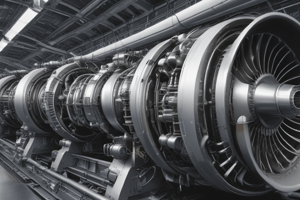Podcast
Questions and Answers
What is the primary function of the compressor in a gas turbine engine?
What is the primary function of the compressor in a gas turbine engine?
- To increase air pressure and temperature (correct)
- To extract energy from hot gases
- To inject fuel into the combustion chamber
- To expel gases at high velocity
Which statement accurately describes the Brayton Cycle?
Which statement accurately describes the Brayton Cycle?
- It involves stages of compression, cooling, and expansion.
- It is a one-time cycle that does not repeat.
- It consists of continuous processes of compression, combustion, and expansion. (correct)
- It only encompasses the combustion stage of a gas turbine.
Which type of gas turbine engine is primarily used in helicopters?
Which type of gas turbine engine is primarily used in helicopters?
- Turbojet
- Turboshaft (correct)
- Turbofan
- Turboprop
What is a key advantage of gas turbine engines?
What is a key advantage of gas turbine engines?
What distinguishes a turbofan engine from a turbojet engine?
What distinguishes a turbofan engine from a turbojet engine?
What does a lower Specific Fuel Consumption (SFC) value indicate?
What does a lower Specific Fuel Consumption (SFC) value indicate?
Which of the following components is responsible for mixing fuel and air in a gas turbine engine?
Which of the following components is responsible for mixing fuel and air in a gas turbine engine?
What is a disadvantage associated with gas turbine engines?
What is a disadvantage associated with gas turbine engines?
Flashcards are hidden until you start studying
Study Notes
Overview
- A gas turbine engine, also known as a jet engine, converts fuel into mechanical energy through combustion.
- Commonly used in aviation, power generation, and industrial applications.
Components
-
Air Intake
- Draws in ambient air.
- Often equipped with a compressor.
-
Compressor
- Increases air pressure and temperature.
- Can be axial or centrifugal type.
-
Combustion Chamber
- Fuel is injected and mixed with high-pressure air.
- Ignition occurs, resulting in high-temperature, high-pressure gas.
-
Turbine
- Extracts energy from hot gases.
- Drives the compressor and other accessories.
-
Exhaust
- Expels gases at high velocity to produce thrust or drive a generator.
Operating Principle
- Brayton Cycle: Continuous cycle involving compression, combustion, and expansion.
- Compression: Air is compressed to high pressure.
- Combustion: Fuel is burned with compressed air.
- Expansion: Gases expand through the turbine, producing work.
Types
-
Turbojet
- Simplest form; all air passes through the engine.
- High speed and efficiency at high altitudes.
-
Turbofan
- Features a large fan; provides additional thrust.
- More fuel-efficient and quieter than turbojets.
-
Turboprop
- Uses a propeller driven by a gas turbine.
- Suitable for lower speed and shorter distances.
-
Turboshaft
- Converts gas energy to shaft power.
- Primarily used in helicopters and industrial applications.
Performance Factors
- Thrust-to-Weight Ratio: Critical for aircraft performance.
- Specific Fuel Consumption (SFC): Efficiency metric; lower values are better.
- Operating Temperature: Higher temperatures improve efficiency but can affect material durability.
Advantages
- High power-to-weight ratio.
- Ability to operate on various fuels.
- Versatile applications across different sectors.
Disadvantages
- High initial cost and maintenance.
- Relies heavily on high-quality materials to withstand operating conditions.
- Environmental concerns related to emissions and noise.
Overview
- A gas turbine engine, or jet engine, transforms fuel into mechanical energy through combustion.
- Widely utilized in aviation, power generation, and various industrial settings.
Components
- Air Intake: Incorporates ambient air and is usually paired with a compressor to optimize intake efficiency.
- Compressor: Enhances air pressure and temperature; may be categorized as axial or centrifugal type depending on design.
- Combustion Chamber: Combines fuel with compressed air to ignite, creating high-temperature and high-pressure gases.
- Turbine: Harnesses energy from hot gases, which powers the compressor and other engine accessories.
- Exhaust: Discharges gases at high velocity, generating thrust in aircraft or driving generators in power applications.
Operating Principle
- Operates on the Brayton Cycle, which consists of continuous phases: compression, combustion, and expansion.
- Compression: Air is compressed, significantly raising its pressure.
- Combustion: Burning of fuel occurs with the already compressed air.
- Expansion: The produced gases expand and flow through the turbine, generating work.
Types
- Turbojet: The simplest form where all air passes through the engine, providing high speed and efficiency at altitude.
- Turbofan: Equipped with a large fan, adds thrust efficiency, resulting in quieter operation and improved fuel economy compared to turbojets.
- Turboprop: Incorporates a propeller powered by a gas turbine, best for lower speeds and shorter distances.
- Turboshaft: Converts gas energy to rotational power, mainly employed in helicopter systems and industrial machinery.
Performance Factors
- Thrust-to-Weight Ratio: A vital parameter for assessing aircraft performance and capability.
- Specific Fuel Consumption (SFC): A measure of efficiency, emphasizing that lower values denote better performance.
- Operating Temperature: Higher temperatures can enhance efficiency but may adversely affect material longevity and integrity.
Advantages
- Exhibits a high power-to-weight ratio, enhancing overall performance.
- Capable of utilizing various fuel types, adding operational versatility.
- Adaptable across a myriad of applications in diverse sectors.
Disadvantages
- Characterized by high initial costs and significant maintenance requirements.
- Depends on high-quality materials to endure challenging operational conditions.
- Associated environmental issues, particularly concerning emissions and noise pollution.
Studying That Suits You
Use AI to generate personalized quizzes and flashcards to suit your learning preferences.




